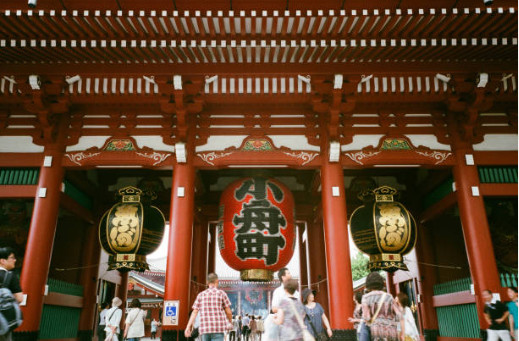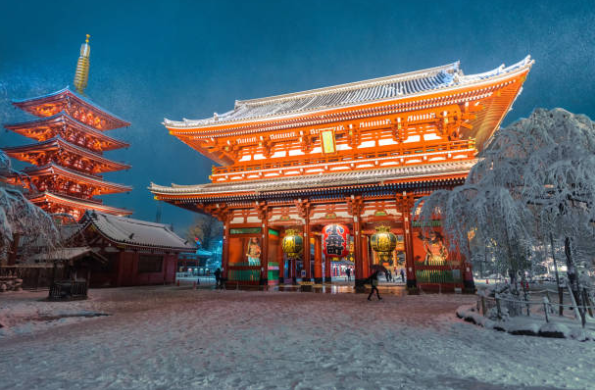Hōzōmon is more than just a gate; it is a symbol of Tokyo’s rich history and culture. From the Niō statues guarding the entrance, the large lantern casting its light, to the giant straw sandals symbolizing strength, every element of this structure tells its own story and holds special meaning.
History of Hōzōmon

Hōzōmon, which means “Treasure House Gate,” is the inner gate of the two large gates leading to Sensō-ji Temple in Asakusa, Tokyo. This two-story gate (known as a nijūmon) serves as the home for many of Sensō-ji Temple’s treasures on its second floor. The first floor houses two large statues, three lanterns, and two massive straw sandals. Hōzōmon stands 22.7 meters tall, 21 meters wide, and 8 meters deep.
The Hōzōmon gate was first constructed in 942 AD by Taira no Kinmasa. However, it was destroyed by fire in 1631 and later rebuilt by Tokugawa Iemitsu in 1636. The gate stood for the next 300 years until it was again destroyed during the Tokyo air raids in 1945 during World War II.
In 1964, the current structure was rebuilt using reinforced concrete, with a donation of ¥150 million from Yonetarō Motoya. Thanks to its fire-resistant reconstruction, the upper floor of Hōzōmon now houses valuable scrolls from Sensō-ji Temple, including a copy of the Lotus Sutra recognized as a National Treasure of Japan, and Issai-kyō, a complete collection of Buddhist scriptures designated as Important Cultural Property.
Design and Key Features of Hōzōmon

Guardian Statues:
Unlike Kaminarimon, which houses four different statues, Hōzōmon contains only two guardian statues located on either side of the front of the gate. These statues, known as Niō, are guardian deities of Buddha. Each of these Niō statues stands 5.45 meters tall and serves as protectors of the gate. Due to these statues, Hōzōmon was formerly known as Niōmon, meaning “Gate of Niō,” before being renamed Hōzōmon.
Large Lanterns:
One of the main features of Hōzōmon is the three large lanterns that adorn the gate. The largest and most prominent is the red lantern (chōchin) hanging in the center of the gate. This lantern is 3.75 meters tall, 2.7 meters in diameter, and weighs about 400 kilograms. It bears the name of Kobunachō (小舟町).
The current iteration of the lantern dates back to 2003 when ¥5 million was donated by the residents of Kobunachō to commemorate the 400th anniversary of the start of the Edo period. On either side of this red lantern hang two copper lanterns, each standing 2.75 meters tall and weighing about 1,000 kilograms. These lanterns are raised during festivals like the Sanja Matsuri to allow tall objects to pass through the gate.
Straw Sandals (Waraji):
On the rear (north) side of Hōzōmon, there are two giant straw sandals (waraji) that each measure 4.5 meters in length, 1.5 meters in width, and weigh about 400 kilograms. These straw sandals not only add aesthetic appeal to the gate but also symbolize the strength and protection provided by the guardian deities.
Visiting Hōzōmon

Visiting Hōzōmon offers a deep cultural and historical experience. You will appreciate the grandeur of traditional Japanese architecture that has been preserved through the years. Besides enjoying the beauty of this gate, you can also visit Sensō-ji Temple, located right behind Hōzōmon. Sensō-ji is one of the oldest and most significant temples in Tokyo, dedicated to Kannon, the bodhisattva of compassion.
So, if you are in Tokyo, don’t miss the chance to visit Hōzōmon and Sensō-ji Temple. Not only will you have a spiritual experience, but you’ll also gain insights into Japan’s rich history and culture.
In addition, visiting Hōzōmon provides an opportunity to immerse yourself in the beauty and grandeur of traditional Japanese architecture while experiencing the spiritual atmosphere at Sensō-ji Temple. Make sure to include this historic site in your Tokyo itinerary.
Address and Location Map of Hōzōmon
This is the second main gate leading to Sensō-ji Temple in Asakusa, Tokyo. The gate is located at the following address:
Address:
2-chōme-3-1 Asakusa, Taito City, Tokyo 111-0032, Japan.
To get to Hōzōmon, you can use various easily accessible transportation methods:
By Train:
- Tokyo Metro: Take a train from Asakusa Station served by the Ginza Line and Asakusa Line. After alighting, it’s only about a 5-minute walk to Hōzōmon.
- Tobu Isesaki Line: If you’re using this line, get off at Tobu Asakusa Station, which is also about a 5-minute walk to Hōzōmon.
By Foot:
- If you’re near Sensō-ji Temple, Hōzōmon is just a 5-minute walk away. The gate is located directly in front of the temple and is the second main gate leading to Sensō-ji.
Walking Route from Asakusa Station:
- After exiting the station, follow the signs to Sensō-ji Temple.
- You’ll pass through Kaminarimon, the first main gate, before reaching Hōzōmon.
Be sure to visit Hōzōmon, as it is rich in history and architecture, making it one of the must-see places when in Asakusa.

Your point of view caught my eye and was very interesting. Thanks. I have a question for you.